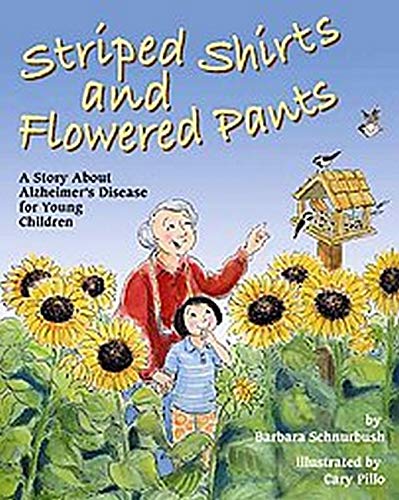Striped Shirts and Flowered Pants
Reading Guide

By: Barbara Schnurbush
Illustrated by Cary Pillo
About this Program
The MSU Extension Alzheimer's Dementia Awareness for ChildrenStorybook program is designed to teach children about a form of dementia.
The goals of the program are:
1) increase awareness and knowledge about Alzheimer’s (a form of dementia) and
2) provide supportive resources to children and families when they have a loved one
diagnosed with Alzheimer's.
The authors of this reading guide are:
- Jennifer Munter, Volunteer Program Coordinator. Jennifer is a former Early Childhood Educator and
has worked with children and their families for over 15 years.
- Marsha A. Goetting, MSU Extension Family Economics Specialist
- Keri Hayes, MSU Extension Program Assistant
Brief Summary
Libby is a young girl who is worried when she notices her Nana is having trouble reading
and remembering things.
Libby's parents explain to her that Nana's brain isn't working right because she has
Alzheimer's. By gaining knowledge about Alzheimer's, Libby begins to understand what
is happening to her Nana.
With her family's love and reassurance Libby is able to find positive ways to interact
with Nana. Libby continues doing all the activities she and Nana love doing together
like planting flowers, feeding the birds, and wearing striped shirts and flowered
pants together.
Questions to Ask
- Libby noticed Nana having trouble remembering things. What were some of the things Nana forgot?
- After Libby witnessed some strange things Nana was doing. She asked her parents and
they told her Nana was having trouble remembering things? What are some strange things Nana did that showed she had signs of Alzheimer's dementia?
- Sometimes Nana gets mad and Libby. Who does Libby go to when her Nana gets mad at her for no reason?
- There are many activities you can do with someone who has Alzheimer's dementia. What were some of the activities Libby did with her Nana?
Activity Enrichment
- Catch and send: If your whole family can play, have them form a circle. Each person in the circle represents a brain cell and together make a healthy brain. Start by rolling a ball back and forth across the circle to one another. Then begin placing barriers in the middle of the circle until no one can successfully roll the ball. After your family is done playing, explain that the ball represented messages or thoughts and the barriers were Alzheimer's. Ask your children how they felt when they could not get the ball rolled to their family member.
Common Reactions
- Sad: A child may feel sad when they see the changes that are happening in the person
with Alzheimer's.
- Curious: A child may have a lot of questions about Alzheimer's.
- Acceptance: A child may start to accept the person with Alzheimer's and find new ways to interact with them.
Other Books in this Program
Other Storybooks and Reading Guides can be found at: https://www.montana.edu/extension/alzheimers/booksandreadingguides.html
Funding for purchase of the storybooks in this program have been made possible by
a grant from the Montana Geriatric Education Center at the University of Montana,
AARP Montana, and by the Endowment fund from National Extension Association of Family
& Consumer Sciences (NEAFCS).



